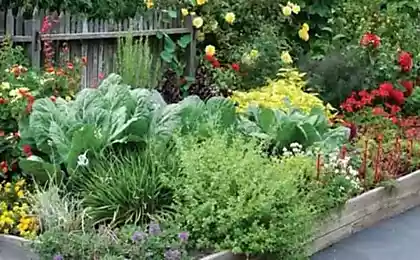267
How to find out the type of soil and why you need it
The question of soil types for many summer residents, especially beginners, seems to be a “Chinese letter”: it is not clear how to define this type, and in general why such difficulties are necessary. This is where the answers to many of the questions that concern us may lie.
Many years ago, my first garden was located on a plot near peat bogs. I couldn’t understand why my beets didn’t grow. Excellent potatoes come out, strawberries, raspberries feel great, greens please, and beets fail, even crying: pathetic, stunted "tails", no matter how you care. I did not know that this vegetable does not like acidic soils (and I had one). Then I decided it was not my plant. : And then, already in another country, my beets grew without any hassle and worries - just sow it in time, and in autumn harvest.
In general, to speak briefly, the knowledge about the characteristics of different soils will help us and with the choice of plants for the garden to determine, and the right methods and techniques for processing your site to choose. Moreover, to go into some purely scientific details in this case is not necessary – to begin with, we will have enough general information.
Mechanical composition of the soil This is one of the most important indicators, and at the same time - one of the easiest to understand and to determine. Soils by mechanical composition are divided into:
To find out what kind of soil on the site, take a handful of earth, evenly moisten it so that the consistency it resembles a thick paste, and roll the “sausage” with a thickness of about 3 mm. Then we try to roll it into a ring and evaluate what happened:
Why is it important to understand this? The mechanical composition of the soil determines its density, water and air permeability, moisture capacity. Different types of soils are differently provided with the necessary plant nutrients and require a different approach.
Okay, heavy-soil richer in nutrition than lungs. But they quickly thicken, after rain, their surface is seized by a crust. They often stagnate water, and because of overhydration, the roots of plants suffer. In such soils, useful microorganisms do not work well, organic matter slowly decomposes, and therefore there may be a nutritional deficit. In the spring, areas with such soil warm up longer, and meltwater from them leave later, so landings have to begin with some delay.
How do you fix the situation? The main method is the application of loosening materials (usually sawdust or sand). Sand can be applied both in spring and autumn, but sawdust - preferably in autumn, and before using them it is useful to moisten with a solution of nitrogen fertilizer. Volumes and proportions are selected in each case, depending on the requirements of the crops that are planned to be planted, and the characteristics of the soil.
Seederates are also well affected; for sowing on heavy soils, it is desirable to choose crops with a strong root system that penetrates deeply into the ground (for example, cereals).
Light soils Water is poorly retained, and along with water, nutrients are lost. But they provide good air exchange and quickly warm up in spring. “Weighten” the soil, increase its moisture capacity can be introduced by the introduction of clay or pond sludge (sapropel). The latter, however, requires pretreatment: after extraction, it is necessarily ventilated and frozen to get rid of chemical compounds harmful to plants.
It is useful on light soils to apply large doses of organic matter (interrupted manure or compost). But peat should be used with caution: it has good moisture capacity, but it can increase the acidity of the soil, and the content of nutrients is not of particular value.
Soil acidity: how to determine and what is affected Another important parameter for us is the soil reaction. What does it matter? In the beginning, I gave the example of beets that will not grow on acidic soil. And there are many such plants. In general, there are 4 groups of cultures, depending on their attitude to this factor:
However, most cultures are quite easy to adapt to fluctuations in pH levels, and in the literature you can find conflicting information about the preferences of a particular species. Typical calcephobes (fans of acid soils) and calcephiles (those that prefer alkaline soils) are relatively few. And yet, if planting does not take into account the requirements of the plant, it is likely to lead to its disease, starvation, poor development or death.
In soils with an increased level of acidity, nitrogen nutrition is disturbed; plants do not receive sufficient amounts of phosphorus, calcium and magnesium, since their content is small or these substances are inaccessible to plants. But there are other compounds that are toxic to the root system. Increased acidity of the soil provokes diseases, because pathogenic microflora in such conditions develops faster.
However, the alkaline reaction is no better: here plants are deficient in magnesium and iron, their leaves turn yellow and fall off. Unadapted to such conditions, cultures get sick, form deformed fruits, and often die.
The most accurate and simple method is to pass a sample for analysis in a specialized laboratory. But this is not always possible, so we will do with improvised means.
An approximate estimate can be given by typical vegetation for the site. But remember: this method is suitable only if you get virgin land. On soils that have already been treated, plants are an unreliable indicator. Nevertheless,
The soil is poured with water (10 g of soil per 25 g of water; you can double the amount if you are more comfortable), thoroughly shaken or stirred and allowed to stand. Then a strip of indicator paper is lowered into the resulting hood and look at what color it has colored:
To deoxidize the soil, dolomite flour, lime (quenched and quick), lime flour, chalk are used. Suitable for these purposes and wood ash, which acts gently but effectively. Doses are selected depending on the level of acidity and mechanical composition of the soil. At the same time, it should be understood that the reaction of the soil changes constantly, and with a single application of fertilizers, we solve the problem only for a while - it is advisable to check the pH of the soil regularly, and if you notice problems with the development of plants - this is the first thing to do in search of the cause.
In fact, this information is sufficient at the initial stage.
Source: www.7dach.ru
Many years ago, my first garden was located on a plot near peat bogs. I couldn’t understand why my beets didn’t grow. Excellent potatoes come out, strawberries, raspberries feel great, greens please, and beets fail, even crying: pathetic, stunted "tails", no matter how you care. I did not know that this vegetable does not like acidic soils (and I had one). Then I decided it was not my plant. : And then, already in another country, my beets grew without any hassle and worries - just sow it in time, and in autumn harvest.
In general, to speak briefly, the knowledge about the characteristics of different soils will help us and with the choice of plants for the garden to determine, and the right methods and techniques for processing your site to choose. Moreover, to go into some purely scientific details in this case is not necessary – to begin with, we will have enough general information.
Mechanical composition of the soil This is one of the most important indicators, and at the same time - one of the easiest to understand and to determine. Soils by mechanical composition are divided into:
- light (sandy and sandy)
- medium-severe (loamy)
- heavy (clay).
To find out what kind of soil on the site, take a handful of earth, evenly moisten it so that the consistency it resembles a thick paste, and roll the “sausage” with a thickness of about 3 mm. Then we try to roll it into a ring and evaluate what happened:
- The soil rolls well, it's plastic, the ring folds easily, and it keeps its shape. clay-heavy;
- Soil rolls into a sausage, but cracks when you try to fold it with a ring. loamy;
- The soil crumbles, you cannot roll anything solid out of it, you cannot fold the ring. sandy.
Why is it important to understand this? The mechanical composition of the soil determines its density, water and air permeability, moisture capacity. Different types of soils are differently provided with the necessary plant nutrients and require a different approach.
Okay, heavy-soil richer in nutrition than lungs. But they quickly thicken, after rain, their surface is seized by a crust. They often stagnate water, and because of overhydration, the roots of plants suffer. In such soils, useful microorganisms do not work well, organic matter slowly decomposes, and therefore there may be a nutritional deficit. In the spring, areas with such soil warm up longer, and meltwater from them leave later, so landings have to begin with some delay.
How do you fix the situation? The main method is the application of loosening materials (usually sawdust or sand). Sand can be applied both in spring and autumn, but sawdust - preferably in autumn, and before using them it is useful to moisten with a solution of nitrogen fertilizer. Volumes and proportions are selected in each case, depending on the requirements of the crops that are planned to be planted, and the characteristics of the soil.
Seederates are also well affected; for sowing on heavy soils, it is desirable to choose crops with a strong root system that penetrates deeply into the ground (for example, cereals).
Light soils Water is poorly retained, and along with water, nutrients are lost. But they provide good air exchange and quickly warm up in spring. “Weighten” the soil, increase its moisture capacity can be introduced by the introduction of clay or pond sludge (sapropel). The latter, however, requires pretreatment: after extraction, it is necessarily ventilated and frozen to get rid of chemical compounds harmful to plants.
It is useful on light soils to apply large doses of organic matter (interrupted manure or compost). But peat should be used with caution: it has good moisture capacity, but it can increase the acidity of the soil, and the content of nutrients is not of particular value.
Soil acidity: how to determine and what is affected Another important parameter for us is the soil reaction. What does it matter? In the beginning, I gave the example of beets that will not grow on acidic soil. And there are many such plants. In general, there are 4 groups of cultures, depending on their attitude to this factor:
- first plants that prefer neutral and slightly alkaline soils (pH 6.0 or more): beets, pumpkins, zucchini, cabbage, onions and garlic, peas, beans, celery, cherries, plums and currants, daffodils, tulips, hyacinths, asters, cloves and others;
- second plants that require a neutral or slightly acidic soil reaction (pH 5.6-6.0): carrots, cucumbers, sown salad, cauliflower and kohlrabi, apple tree, pear, begonia, gladioli, roses and others;
- third-group - plants for which a slightly acidic soil reaction (pH 5.1-5.5) will be favorable: potatoes, corn, tomatoes, radishes, raspberries and blackberries, gooseberry, hazel, western thuya, irises, primrose, lilies, pelargonium and others;
- fourth-group - plants that prefer acid soils (pH 4.0-4.5): sorrel, ordinary pine, azaleas and rhododendrons, heather, lilies, lingonberries and cranberries, blueberries.
However, most cultures are quite easy to adapt to fluctuations in pH levels, and in the literature you can find conflicting information about the preferences of a particular species. Typical calcephobes (fans of acid soils) and calcephiles (those that prefer alkaline soils) are relatively few. And yet, if planting does not take into account the requirements of the plant, it is likely to lead to its disease, starvation, poor development or death.
In soils with an increased level of acidity, nitrogen nutrition is disturbed; plants do not receive sufficient amounts of phosphorus, calcium and magnesium, since their content is small or these substances are inaccessible to plants. But there are other compounds that are toxic to the root system. Increased acidity of the soil provokes diseases, because pathogenic microflora in such conditions develops faster.
However, the alkaline reaction is no better: here plants are deficient in magnesium and iron, their leaves turn yellow and fall off. Unadapted to such conditions, cultures get sick, form deformed fruits, and often die.
The most accurate and simple method is to pass a sample for analysis in a specialized laboratory. But this is not always possible, so we will do with improvised means.
An approximate estimate can be given by typical vegetation for the site. But remember: this method is suitable only if you get virgin land. On soils that have already been treated, plants are an unreliable indicator. Nevertheless,
- on acidic They will show moss, sedge, horsetail, sorrel;
- signify neutrality Soils serve mother-and-stepmother, clover, nausea and nettle;
- on low-alkaline swan and field mustard grow
The soil is poured with water (10 g of soil per 25 g of water; you can double the amount if you are more comfortable), thoroughly shaken or stirred and allowed to stand. Then a strip of indicator paper is lowered into the resulting hood and look at what color it has colored:
- red: high acidity
- orange-medium-acid soil
- yellow-orange - weak acidity
- Yellow-green – neutral reaction
- The greenish blue is alkaline soil.
To deoxidize the soil, dolomite flour, lime (quenched and quick), lime flour, chalk are used. Suitable for these purposes and wood ash, which acts gently but effectively. Doses are selected depending on the level of acidity and mechanical composition of the soil. At the same time, it should be understood that the reaction of the soil changes constantly, and with a single application of fertilizers, we solve the problem only for a while - it is advisable to check the pH of the soil regularly, and if you notice problems with the development of plants - this is the first thing to do in search of the cause.
In fact, this information is sufficient at the initial stage.
Source: www.7dach.ru























